Our Lady of Doncaster facts for kids
Our Lady of Doncaster is a special place of worship, also known as a Marian shrine, located in Doncaster, South Yorkshire, England. It's dedicated to the Virgin Mary. The original statue of Mary in the Carmelite friary (a type of monastery) was destroyed a long time ago during a period called the English Reformation. A new shrine was built in St Peter-in-Chains Church in Doncaster in 1973. People celebrate the feast day of Our Lady of Doncaster every year on June 4.
Contents
The Carmelites and the First Shrine
The first Shrine of Our Lady of Doncaster was part of a Carmelite friary in the town during the Middle Ages. The Carmelite friars were a group of religious men. Their friary in Doncaster was started by John Nicbrother and Richard le Ewere. They got permission on November 30, 1350, to build a church dedicated to St Mary and homes for themselves.
The Doncaster friary became very important. This was probably because it was located on the Great North Road, a main route from London to Scotland. Doncaster was a good place for travelers to stop. Many important people visited the shrine. For example, King Henry VII visited after his coronation. His daughter, Margaret Tudor, also stopped there in 1503 on her way to become Queen of Scotland. Other royal visitors included Henry IV and Edward IV. During the medieval period, the Shrine of Our Lady of Doncaster was the most important shrine dedicated to the Virgin Mary in Yorkshire.
Special Gifts to the Shrine
Many people gave gifts to the shrine over the years. These gifts showed their faith and respect for Our Lady of Doncaster.
- In 1483, Anthony Woodville, 2nd Earl Rivers, who was a protector of the young King Edward V, gave his special hair-shirt to Our Lady of Doncaster. He wore this shirt as a sign of his devotion.
- In 1449, Constance Bigod, a wealthy widow, left her fancy belt, which was decorated with silver and gold, to the shrine.
- Important people were sometimes buried near the shrine. For example, Roger de Bankewell was buried there in 1366. Later, Sir Robert Welles and his wife were buried there. In 1484, Margaret Cobham, wife of Ralph Neville, 2nd Earl of Westmorland, asked to be buried there. Her tomb was so beautiful that it was saved when other religious buildings were destroyed.
- In 1482, Sir Hugh Hastings, who was going on a trip against the Scots, left money to buy wax for candles to burn during Mass at Our Lady's altar.
- In 1506, his daughter-in-law, Katherine, gave her "tawny chamlett gown" to Our Lady of Doncaster. This rich fabric was likely used to make special clothes for the statue of Mary.
- The Northumberland Household Book, a record of expenses, shows that money was paid each year to keep a wax candle burning daily before Our Lady's statue.
- Alice West of Ripon gave Our Lady of Doncaster her "best bedes" (which were likely rosary beads).
- For Princess Margaret Tudor's visit, John Twisilton gave a silver-gilt crown.
- In 1517, King Henry VIII's records show money was spent on a large wax candle for Our Lady of Doncaster for four years.
The Story of Robert Leche's Miracle
Just before the English Reformation, in 1524, a famous story spread about a miracle involving Robert Leche and his family. They were saved from drowning after praying to Our Lady of Doncaster.
The full story was written down and is called "A curious account of a reputed Miracle." It tells how on July 15, 1524, William Nicholson was crossing the River Don with a wagon pulled by oxen and horses. In the wagon were Robert Leche, his wife, and their two young children.
Suddenly, because of strong wind and rain, the wagon was swept downstream. The first horse drowned, and the wagon flipped over. Everyone in the wagon cried out to God and to Our Blessed Lady of Doncaster. Each person managed to call out to Our Lady and was saved. Robert Leche's wife was carried over 300 feet downstream, with the wagon rolling over and over.
People on the riverbank knelt and prayed, asking Our Lady of Doncaster to show a miracle if she ever had. And she was saved! She shouted that she was well and that Our Lady of Doncaster had saved her.
To prove the story was true, William Nicholson, Robert Leche, his wife, and children came to Our Lady of Doncaster on St Mary Magdalene's Day. They told everyone about the miracle and swore it was true in front of the Prior (the head of the friary) and many witnesses. On that day, the miracle was celebrated with bells and singing in front of more than 300 people.
The Shrine's Destruction
During a time of rebellion called the Pilgrimage of Grace, the White Friars friary was used by lords to talk with the rebel leader, Robert Aske. After this, the Carmelite Prior, Laurence Cook, was arrested. The friary was later closed down, like many others, during the Dissolution of the Monasteries in 1538.
The King's officials took an inventory of everything in the friary. However, the statue of Our Lady of Doncaster had already been removed by order of Archbishop Lee. We don't know exactly what happened to the statue after it was taken. Some historical records suggest that other famous statues of Our Lady, like those from Walsingham and Ipswich, were brought to London and burned. A letter from Bishop Hugh Latimer to Thomas Cromwell mentions the image of Our Lady of Doncaster by name, suggesting it might have been burned with others.
St Peter-in-Chains Church
A new Roman Catholic church in Doncaster, called St Peter-in-Chains, was opened in 1855. A new shrine to Our Lady of Doncaster was created there in 1868. A company in London called Phyffers made the new statue.
This church had a special carving above its main entrance called a tympanum. It showed a statue of Our Blessed Lady holding Jesus, with figures of St Peter and St Charles Borromeo on either side. This carving was made from Roche Abbey stone and was considered very beautiful.
Interest in Our Lady of Doncaster slowly grew again. The Marian year of 1954, a special year for devotion to Mary, helped to restart this devotion. The Bishop of Leeds, John Carmel Heenan, even wrote a prayer in honor of Our Lady of Doncaster.
Modern Times
A brand new St Peter-in-Chains Church was opened in 1973. The shrine of Our Lady of Doncaster was moved to this new church. The statue of Our Lady of Doncaster now stands in a round chapel on the north side of the church. The statue made by Phyffers is placed in a beautiful oak reredos (a screen behind the altar). Around it are modern stained glass windows showing scenes like Saint Joseph, the Annunciation (when Mary was told she would have Jesus), the Nativity (the birth of Jesus), and the Assumption (Mary being taken into heaven).
Around the church garden, there are Stations of the Cross, which are images showing Jesus's journey to his crucifixion. Each of these stations includes a small piece of stone from a religious building dedicated to Our Lady that was destroyed during the Reformation.
The new church has an interesting octagonal (eight-sided) shape. Some parts from the old church, like the Tabernacle Door designed by John Francis Bentley, four reredos panels, and the altar, were moved and used in the Blessed Sacrament Chapel of the new church.
See also



